Are the Ottawa Senators finished their rebuild? According to general manager Pierre Dorion they are, who went so far as to say, “this is going to be the fun part. The rebuild’s done, now we’re stepping into another zone, I would call it.” The claim, while bold, isn’t unwarranted, especially after seeing how well many of their prospects have progressed over the past couple of seasons. The team is on the precipice of something big, and if they stay patient and stick to the plan that was set out when they began the rebuild, good things should start happening very soon.
With that shift in mentality, the Senators prospect pyramid is going to start looking very different as more prospects graduate and fewer top picks come in to replace them. That’s simply the trajectory of competitive teams; picks and prospects are seen as more expendable in favour of veteran talent. Fans can already see that shift starting to take place in Ottawa, as the Senators’ 2021 draft class was much more focused on adding depth talent that will eventually fill out the roster rather than compete for first-line minutes.
Latest Senators Content:
- Senators’ Goaltending Depth After Free Agency
- Senators News & Rumors: Tkachuk Denies Trade Rumors & More
- Jake Chiasson: Everything to Know About Senators’ New Acquisition
- NHL Rumors: Oilers, Hurricanes, Senators
- Xavier Bourgault: Everything to Know About the Senators’ New Acquisition
But it’s also true that the Senators have done very well in the past with underrated prospects. Nearly every prospect they’ve taken in the first and second rounds have had caused some analysts to wonder if they couldn’t have gotten a better player. Yet it was Brady Tkachuk, Thomas Chabot, and the rest of the young guns in Ottawa that were the hottest team in the NHL after the 2021 All-Star break and the only team in 2020-21 to never get shut out. There’s a lot of hope around the franchise after a showing like that, and much of that still revolves around the team’s prospects and future. So, without further ado, here’s the 2021-22 Senators Prospect Pyramid.
What is a Prospect Pyramid?
Created by YouTube personality and Sportsnet correspondent Steve Dangle, the Prospect Pyramid was designed to be a cleaner and less divisive model to rank an organization’s prospects. Sometimes, finding the difference between the team’s 10th and 14th best prospects is so minute that separating the two is a matter of splitting hairs. Hence, the pyramid, where prospects are grouped into tiers according to their NHL potential.
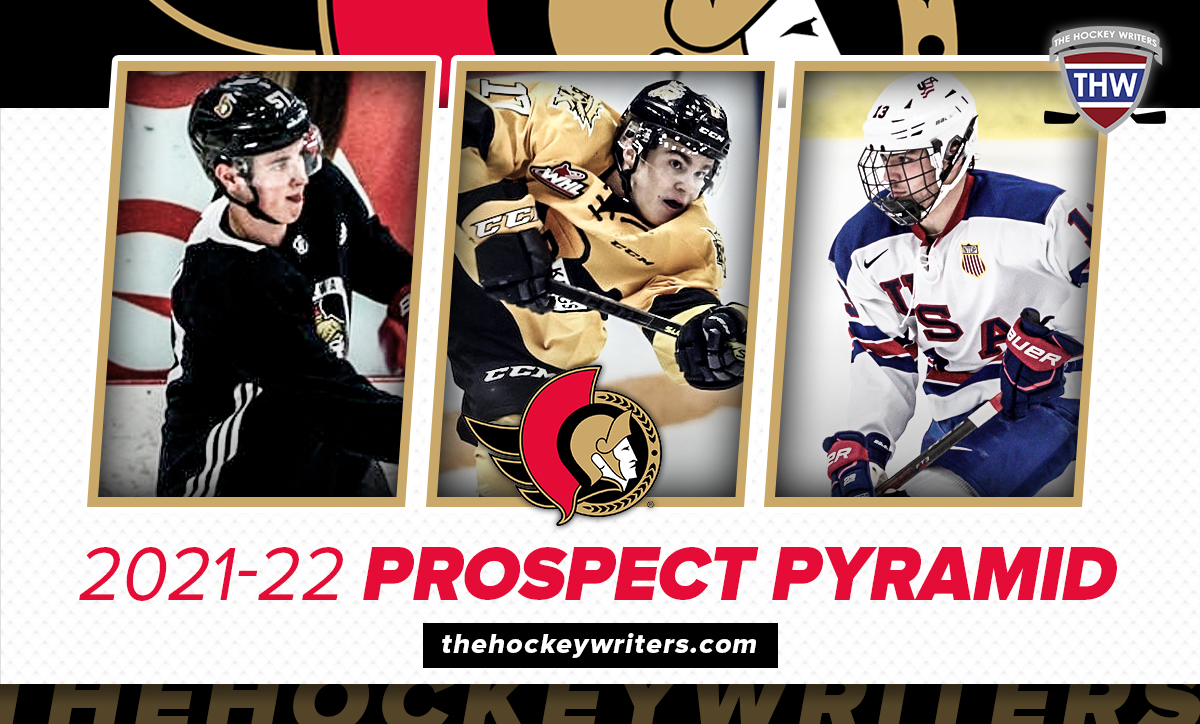
Dangle’s creation has since become the new standard for organizing prospects. Below is a brief description of the six tiers he created, which have been transcribed by THW’s Brandon Share-Cohen.
Tier 1 – Elite talent (Auston Matthews, Connor McDavid-level talent)
Tier 2 – Very, very good prospects with a real chance of being top-six forwards, top-two defenders or good starting goalies
Tier 3 – Good players who fall just short of Tier 2, perhaps due to lower ceilings, but who are distinctly better than tier’s below them
Tier 4 – Distinct shot at making an NHL roster and being a contributor (top-nine forward, bottom-four defender, fringe starter or backup goaltenders)
Tier 5 – Players who likely don’t project to be anything more than a role player in the NHL as their ceiling – these players’ chances of making the NHL aren’t very high compared to their comrades (sometimes due to being relatively unknown at this point)
Tier 6 – Players who are a longshot to make the NHL
Additions, Subtractions & Graduates
The Senators had a huge influx of talent from the 2020 Draft, but have recently started to shift gears into building a team that can compete soon, rather than one with its sights set several years down the road. Since November 2020, these are the prospects who have been added and left the organization.
Additions
Trades: Clark Bishop
Free Agents: Kole Sherwood
Draft: Tyler Boucher, Zack Ostapchuk, Ben Roger, Oliver Johansson, Carson Latimer, Chandler Romeo
Subtractions
Trades: Joey Daccord (Seattle Kraken), Logan Brown (St. Louis Blues)
Free Agency: Jack Kopacka, Mike Amadio, Zach Magwood, Brandon Fortunato, Marcus Hogberg, Jonathan Davidsson
Graduates
Played more than 25 games: Tim Stützle, Josh Norris, Erik Brannstrom, Drake Batherson, Artyom Zub
Played more than 50 games, overall: None
Tier 1: Empty
Like last year, Tier One remains empty, but that’s hardly a bad thing. The team is beginning to transition out of their rebuild, and for that to happen, their top prospects should be playing in the NHL. That’s clearly the case in Ottawa, where Tkachuk is playing a major role on the team and giving the Senators an excellent player to build around.
However, I do want to make one slight correction from my previous prospect pyramid, and that’s to place Tim Stützle in Tier One. I was hesitant last year, being that he wasn’t considered a generational talent like Matthews or McDavid, but everything else he did proved he was one of the premier prospects available in 2020. From his World Junior dominance to his record-setting rookie totals in the Deutsche Eishockey Liga (DEL), Germany’s top hockey league, he was clearly in contention with the likes of Quinton Byfield.
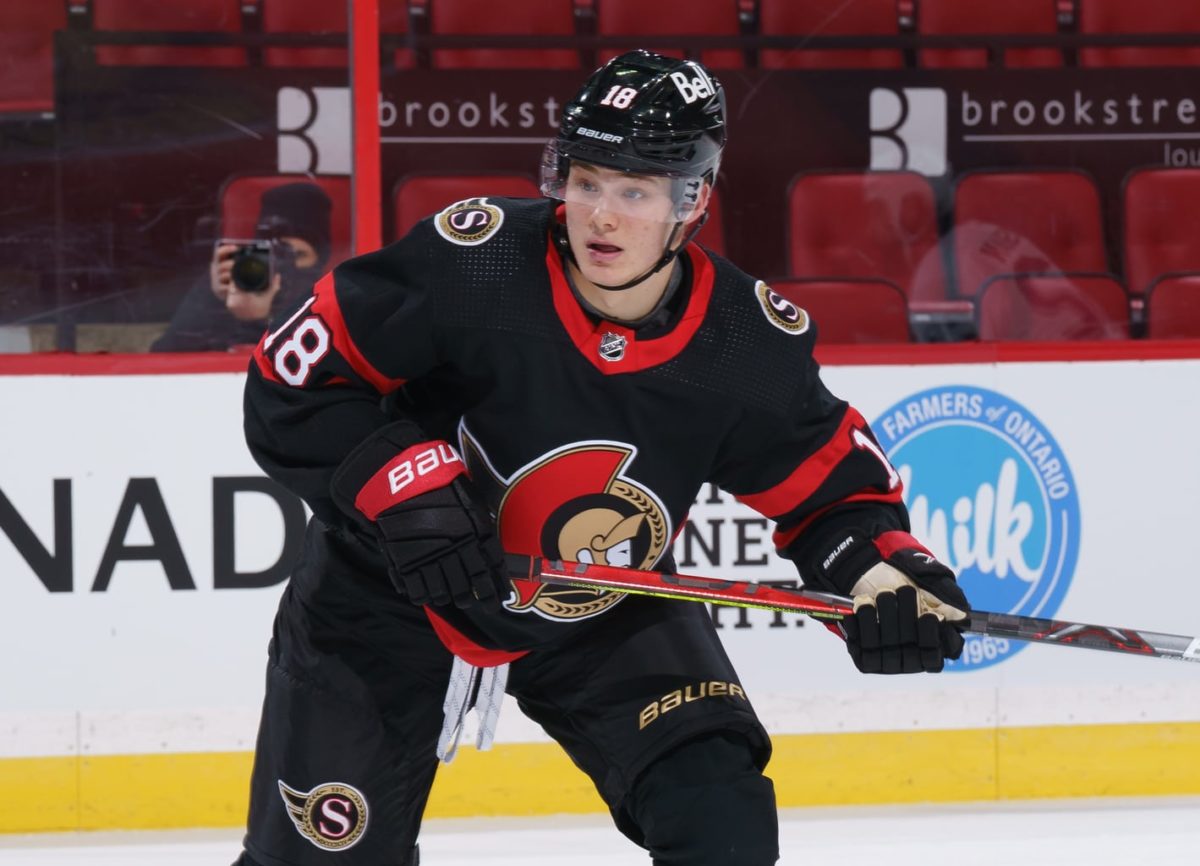
He continued his streak of success last season as an NHL rookie, scoring 12 goals and 29 points in 52 games with the Senators. While it’s unlikely he ever leads the league in scoring, there’s no question he has demonstrated the talent necessary to anchor the first line in the future. However, with his graduation from prospect to regular, Ottawa’s Tier One will likely remain empty for some time. They want to win more games, after all, which means they won’t pick at the top of the draft anymore. But if that’s the price for a championship, then it was worth it.
Tier 2: Sanderson, Grieg, Gustavsson
Jake Sanderson remains in Tier Two but is looking more and more like a truly elite two-way defenseman. After finishing his freshman season with the University of North Dakota, where he was named to the National Collegiate Hockey Conference All-Rookie Team as well as the All-Tournament Team, he was selected to Team USA Blue for the 2021 World Junior Summer Showcase. There he led all defencemen with 14 shots and sat third among defenders with four points in four games, despite not being known as an offensive defenseman. He also helped the United States claim the Gold medal at the 2021 World Juniors in Alberta. There’s little he can’t do, and he projects to be a perfect pairing for Thomas Chabot in the future. While not quite at Tier One, he’s not all that far away from it.
Ridly Greig is the lone forward in Tier Two and looks like a future star for the Senators. Last year, I had him in Tier Four, as I wasn’t sure what his upside was beyond a grinder. However, last season, he established himself as a dynamic threat at all ends of the ice and one of the Senators’ best forward prospects. With the Western Hockey League’s (WHL) Brandon Wheat Kings, he scored 10 goals and 32 points in 21 games, a pace that would have seen him hit 103 points over a full season. It was the ninth-highest point total in the league that season while being the youngest player to hit the 30-point plateau. He also managed to appear in seven American Hockey League (AHL) games, where he added a goal and three points to his resume.
His strong 2020-21 season has given him a leg up this season, and it’s clear he’s become one of the Senators’ top forward prospects. Development coach Shean Donovan said, “he has the skill, he has the brains. He plays a nasty game and I love the way he plays because he’s fearless. And coaches love him because he knows where to go and how to play” (from ‘Senators’ Ridly Greig wants to earn NHL job in camp: ‘I’m going to play my heart out every time I’m on the ice’’, The Athletic – 13/09/21). The only concern I have right now is whether he can reign in his aggression; a cross-check to Pierre-Luc Dubois during the 2021-22 preseason resulted in a two-game suspension, which will include his eventual NHL debut. But if he can do that, he’ll fight for top-line minutes, and could make a deadly combination alongside Tkachuk.
Filip Gustavsson is the last player in Tier Two and looks to be the future of the Senators’ goaltending. The Swedish netminder made his NHL debut last season and recorded two wins in his first two starts and finished with five wins in nine games and a 0.933 save percentage (SV%). While the sample size is small, he still was one of the most impressive goalies in Ottawa, and now with Joey Daccord gone, he has a great chance to overtake Anton Forsberg and seize the backup position behind Matt Murray. The Senators will still have to be patient with the 23-year-old, but he has the potential to be the team’s starter in the next few seasons.
Tier 3: Pinto, Bernard-Docker, Thomson, Formenton, Järventie, Sokolov, Boucher, Ostapchuk, Sogaard, Abramov
I desperately wanted to put Shane Pinto in Tier Two. He’s a Hobey Baker finalist and looked fantastic in his 12-game stint last season with the Senators, where he scored a goal and seven points. This season, in the rookie games against the Montreal Canadiens’ prospects, he was easily the most dominant player aside from a bad turnover in game one. His progression from an underrated second-round pick in 2019 to one of the team’s top prospects has been one of the Senators’ biggest success stories. He’s set to start the season in the NHL as the team’s fourth-line center, but could very easily overtake Chris Tierney on the second line, as the veteran has not been playing well in preseason.
But the thing that keeps Pinto out of Tier Two is his long-term upside. He doesn’t project to be a top-line player and his skating needs a little work, but he should become a reliable middle-six center who can anchor his line easily. TSN’s Craig Button compared him to Zach Hyman, saying, “he’s got physical play, he’s a heavy player and he’s got skill. He’s got good hockey sense and he’s a competitor. You look at those players that you can move around and their ability to adapt is something coaches love when you’re talking about flexibility” (from ‘SNAPSHOTS: TSN’s Craig Button gives his thoughts on the Senators’ North Dakota prospects…Christian Wolanin making his way to L.A….The Arty Party clears waivers’ – Ottawa Sun, 30/03/21).
Following Pinto is another University of North Dakota alumni, Jacob Bernard-Docker. He had a five-game NHL stint last season and looked decent, recording five blocks, six shots, and three hits while averaging 13 minutes of ice time, but didn’t look quite as ready as his university teammate and will likely benefit from a season or two in the AHL. He projects to be a solid top-four defender who can contribute on all ends of the ice, but will specialize in shutting down opponents. Along with Sanderson and Chabot, Ottawa has a trio of defenders that are starting to look like the beginnings of a Wade Redden, Zdeno Chara, and Chris Phillips.
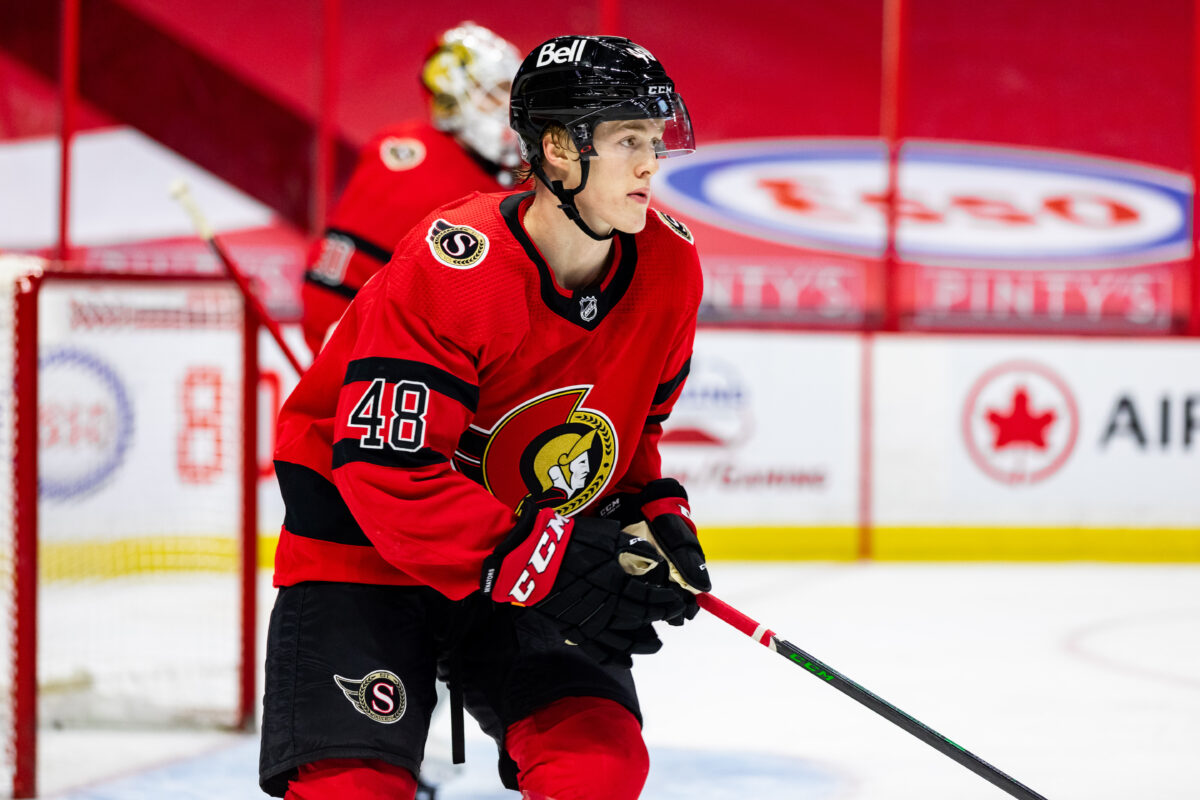
Joining that cohort is Lassi Thomson, who took huge steps forward in his development. The Finnish defender returned to North American after spending a season and a half abroad in his home nation, and it’s made a world of difference in his game. Before his departure, he was criticized for his defensive awareness, which many young offensive-minded defensemen struggle with. But while with Ilves of Finland’s Liiga, he developed a more all-around presence, which he demonstrated when he joined Belleville part-way through 2020-21, playing 35 games and scoring 13 points. He was equally strong during rookie camp and in the 2021-22 pre-season, but will still start the season in the AHL due to the Senators’ already crowded defence.
However, there are still some concerns with his overall game. Thomson was great on the powerplay, but not as strong on the penalty kill, and he still isn’t as strong defensively. But according to Belleville’s head coach Troy Mann, “…he may not be the flash-and-dash type defenceman, but from our coaching perspective, he plays hard, skates well and competes. He’ll battle out in front of the net and boxes out very well…I thought his improvement start to finish was excellent,” (from ‘Senators’ AHL coach Troy Mann on Erik Brannstrom, Egor Sokolov, goaltending situation and more: Q&A’, The Athletic – 16/09/21). Senators’ head coach D.J. Smith would agree, and after another season in the AHL, Thomson will likely be ready to take the next step.
Alex Formenton is another name that some may have in Tier Two, but I’ve placed him in Tier Three largely because of his potential. Fans have been eagerly awaiting his arrival ever since his debut in 2017-18, mere months after being drafted in the third round. The excitement only grew when he made the team out of training camp the following season and played nine games in the NHL, during which he scored his first goal, before being returned to the London Knights. In the AHL, he frequently played alongside Josh Norris and Drake Batherson, forming one of the league’s most dangerous units, and in the 2021-22 preseason, they’ve rekindled that chemistry, causing some to wonder if that should be Ottawa’s second line this season.
The only concern I have is that without great linemates like Norris and Batherson, he doesn’t have the same impact. Last season, he scored just four goals in 13 games, a steep decline from his 27 in 2019-20. Granted, he did spend 20 games in the NHL last season, where he put up four goals and six points, but he seems to be more of a supporting forward and thus will thrive or struggle depending on who is around him. So far in preseason, he’s been reunited with his AHL line mates on the top unit, which is great news for him, and should the Tkachuk contract situation drag on much longer, he could see a huge boost in his production.
Related: Ottawa Senators’ 2020-21 Prospect Pyramid
Roby Järventie retains his spot in Tier Three after making his North American debut last season and did so in fantastic fashion, scoring two goals and three points in four games. It was just the latest in a long line of accomplishments for the Senators’ 2020 second-round pick after he lit up the Finnish Liiga as a teenager, scoring 14 goals and 25 points in 43 games. Only Juuso Parssinen and Anton Lundell outscored him among U20 players in the league, and both are two years older and have two more seasons in the league than him. This season will be one of transition for the Finn and there will be growing pains, but based on everything we’ve seen, Ottawa looks to have another second-round gem on their hands.
Speaking of second-round gems, no player is more popular right now than Egor Sokolov. The big Russian winger has stolen the hearts of nearly every fan with his cheerful, relaxed demeanour, his work ethic, and his high-end skills. With the Belleville Senators lacking a top scorer after losing Norris and Batherson to the NHL, it was Sokolov who stepped up and filled that gap, leading the team and all AHL rookies with 15 goals and 25 points. He was dead-set on claiming a roster spot this season, but after the acquisition of Zach Sanford, there wasn’t space for him, so he too will start the season in Belleville. The Senators are weak on the right side, though, and another strong season will make him a sure-fire addition to the 2022-23 roster.
Next, we have our first member from the Senators’ 2021 draft class, Tyler Boucher, who was selected 10th overall. Plenty has already been said about the selection – many saw it as a huge reach especially with all the talent still available, while others defended it, claiming it was always who the team was going to select. Regardless of your opinion, there’s no question he’s a talented prospect who will fit in very nicely with the organization. Last season, he played primarily with the United States Development Program U-18 Team, scoring six goals and 11 points in 12 games. Had he played the full season with the team and kept up that pace, he would have ended fifth in team scoring, putting him in the same field as Aiden Hreschuk and Sean Behrens.
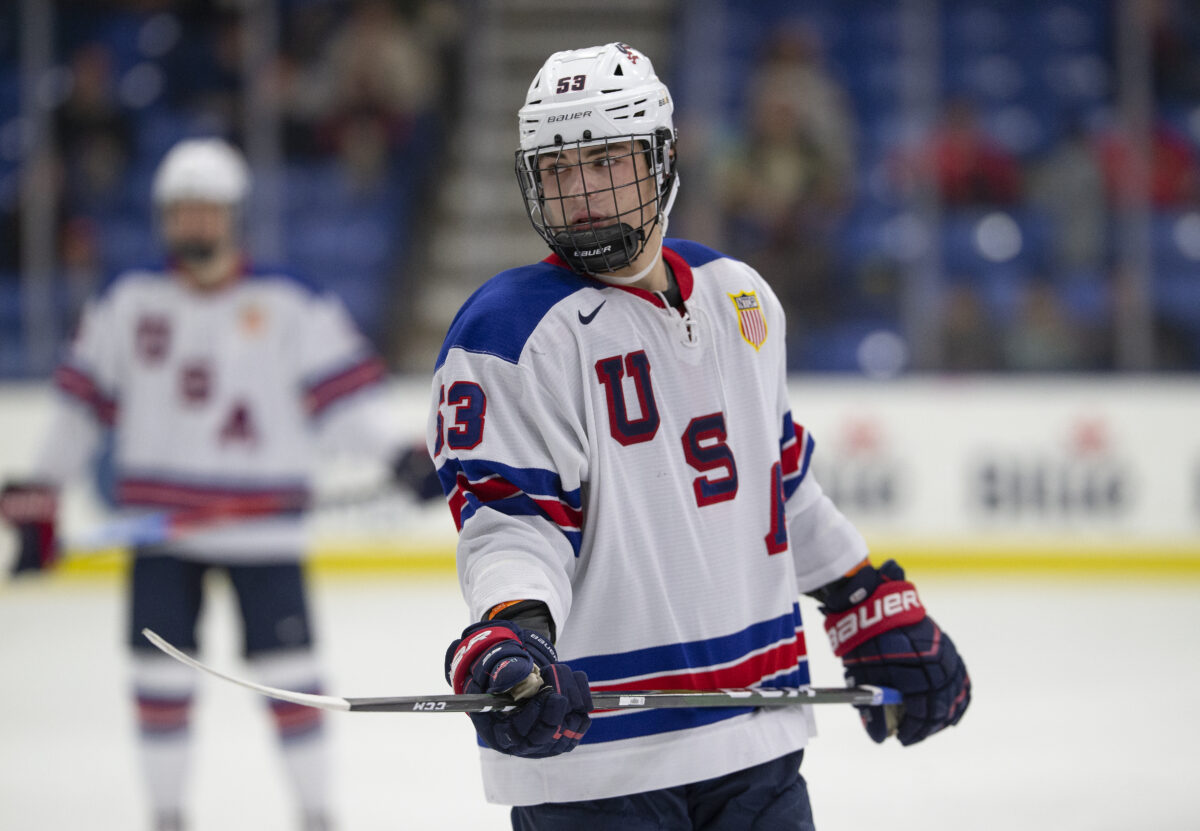
But Boucher made his name with his physicality, and arguably no other 2021 prospect was as effective as him when it came to laying out hits and using his body to drive the play. He’s incredibly difficult to handle when he sets up in front of the net, using his strength to remove anyone he doesn’t want around him. The only question remaining is how will his offense translate to higher leagues? Injuries prevented him from playing much of the 2020-21 season, so his freshman season at Boston University will give scouts a better picture of his total upside. Right now, however, he projects to be a middle-six forward and will need to improve his hockey awareness and speed to make an impact at the highest level.
Zack Ostapchuk also makes Tier Three and joins Boucher as the sole two representatives from the 2021 draft class. The Senators had a very clear vision at last year’s draft, and that was to add players who can fill out the rest of the lineup. Ostapchuk looks to be exactly that. He’s already 6-foot-3, nearly 200-pounds, and plays an in-your-face style while adding strong offensive skills. There’s a chance that he could be a top-six player, and after a great training camp, the Senators made him their first 2021 prospect to earn an entry-level contract before they returned him to the WHL’s Vancouver Giants. It’s almost a given he’ll top his nine goals and 16 points he put up last season, but the question is now by how much.
Like Gustavsson, Mads Sogaard is the sole goaltender in his tier. The Senators’ second-round pick from 2019 has had a rough couple of seasons, from temporarily losing the starting job with the Medicine Hat Tigers to being Denmark’s starting goalie at the World Juniors when they were relegated for the first time since 2014. But things clicked for him in 2020-21, after choosing to play in his home of Denmark. While not the strongest European league, he still finished with a 0.922 SV% in 16 games as a 20-year-old. Once their season concluded, he, like Jarventie, joined the Belleville Senators and went on an incredible streak, losing zero games in seven starts and recording a 0.914 SV%. He’ll still have to battle for the starting job this season, but there’s a lot of potential there.
The final member of Tier Three comes with an asterisk. Vitali Abramov, acquired in the Matt Duchene deal in 2019, started the 2020-21 season in Finland, then came over to Belleville, where he scored 19 points in 23 games. He was called up for two NHL games but went pointless in those appearances. Despite the immense skill, the 5-foot-10 winger struggled to get opportunities, especially with the franchise focusing a lot on size recently, and so he decided to sign a two-year deal in the KHL. He could still return, especially if the next two seasons go well, but at this point, his time with Ottawa seems to be over.
Tier 4: Crookshank, Tychonick, Kleven, Novak, Daoust, Roger, Merilainen, Kelly
Tier Four includes a lot of players who have the potential to become valuable prospects, but a lot of questions still surround their development. Whether it’s transitioning to professional leagues or proving their abilities over a full season, I’m treating a lot of these prospects with a ‘wait-and-see’ mentality.
Angus Crookshank headlines Tier Four and is likely the best candidate to move up following a strong season. A fifth-round pick in 2018, he’s one of the few Senators’ prospects who stand under 6-foot. That hasn’t held him back, though, as he’s continued to score at high rates in every league he’s played in. He spent three seasons with the University of New Hampshire, ending his collegiate career with 63 points in 90 games, before signing his entry-level deal with Ottawa last season and joining Belleville. There, he found instant chemistry with Sokolov, and the pair lit up the AHL through the home stretch, with Crookshank scoring 16 points in 19 games. While not currently a well-rounded player, his offensive game is very well developed, which could grant him more opportunities in the future.
Jonny Tychonick transferred o the University of Nebraska-Omaha after spending two seasons at the University of North Dakota, where he played alongside Bernard-Docker. Without him, he didn’t look quite as solid, scoring eight points as a junior, and was a minus-8 in 23 games, which ranked second-worst on the team. He’s a great skater and has shown potential to be a power-play quarterback but if he doesn’t take a significant step forward this season, it’s doubtful he’s offered an entry-level deal once he finishes his collegiate career.
Tyler Kleven is in a similar boat, albeit two years younger and thus has the benefit of the doubt. He too is a smooth skater with great mobility, but where they differ is how they defend; Tychonick plays a more offensively-minded game, while Kleven thrives on dishing out bone-crushing hits and playing the physical side. Last season could not have gone better for him, either, as he helped North Dakota capture another National Collegiate Hockey Conference title and was part of the American World Junior team that captured the gold medal. I’ve been critical of the Senators’ selection of him in the past, but if he can round out his defensive awareness, they may have a solid player here.
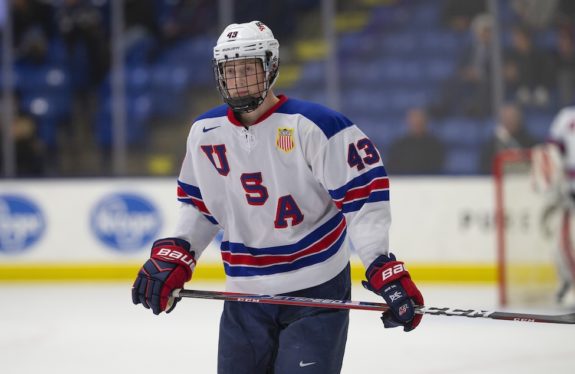
Jakov Novak is entering his fourth season in the NCAA, but his first with Northeastern University, after spending his first three seasons at Bentley. He’s consistently sat at the top of the team’s scoring and was even nominated for the Hobey Baker Award last season after scoring 17 points in 15 games. As a bigger player, he has the opportunity to stand out with Northeastern, who had one of the smallest teams last season. He’s a good candidate to earn an entry-level deal this season if all goes well, but I’m not sure how well his skill set will transition to the professional ranks.
Philippe Daoust also possesses a good offensive skill set and a decent size to earn a contract but may struggle when he turns pro. Last season, he finished second in scoring for the Moncton Wildcats with 28 points in 22 games but missed all the team’s playoff games. However, he had a strong camp and was one of the nine players who were assigned to Belleville to attend their camp, although he still will likely join the Wildcats for their season before much longer as he hasn’t inked his entry-level deal yet. He possesses good speed and can transition well from defence to offence, but it seems the Senators are waiting to see if he can take that extra step this season in the Quebec Major Junior Hockey League (QMJHL).
Ben Roger was an early cut from the Senators’ training camp and that likely had to do with him not playing any competitive hockey last season due to the Ontario Hockey League’s (OHL) shutdown. One of two second-round picks Ottawa made in 2021, he offers a similar package to Kleven, in that he’s a big, smooth-skating defensive-minded defenseman with little in the way of offensive upside. However, he possesses a better shot and work ethic that makes him a strong candidate to make the NHL in the future. The Senators will be paying close attention to his development in the OHL this season.
Carson Latimer, the Senators’ fourth-round pick in 2021, had a good rookie campaign in the WHL last season, scoring 16 points in 22 games with the Edmonton Oil Kings, and demonstrated strong instincts off the puck. But he seems to be more of a supporting player right now and will live or die by the linemates he has. Like many of the prospects on this list, he’ll need to develop a more well-rounded game this season to prove he belongs in the NHL someday.
I think that it’s fair to say that Leevi Merilainen was the biggest unknown after the 2020 Draft, especially after being taken in the third round despite not being ranked coming into the draft. But one season later, he’s one of the most closely watched, especially after joining the Kingston Frontenacs for the 2021-22 season after he was selected in the CHL Import Draft. He didn’t play in the Liiga last season, but was one of the best goalies in the Finnish U20 league, posting a 0.934 save percentage over 22 games, which led the league and included three straight shutouts. He likely projects to be a decent backup goalie at this point, but he’s one of the more intriguing prospects heading into this season and beyond.
Parker Kelly doesn’t fit with the rest of Tier Four in that you pretty much know what you’re getting with him at this point. He’s a bottom-six energy player who will work hard in any situation. He has some offensive upside, and he demonstrated that in his NHL debut last season, notching his first goal as a Senator on his only shot on goal. But he promises to be better than just a replacement-level forward. Offensively, he’s made big improvements, repeating the 10 goals he scored in 2019-20 this season, but doing so while playing in nearly half the number of games. He’s solid in the faceoff circle and can play physically despite not being the biggest player on the ice. Once again, keep an eye on him this season, as he’ll almost certainly appear in a few more NHL games.
Tier 5: Reinhardt, Kastelic, Guenette, Mandolese, Johansson, Romeo, Sherwood, Bishop
Cole Reinhardt made his AHL debut last season, and it didn’t go badly, but it wasn’t anything to write home about. In 33 games, he had six goals and 12 points, which is respectable for a rookie. However, he was drafted as a 20-year-old, and when compared to Sokolov, another overaged pick in 2020, he wasn’t even in the same ballpark. He has some solid skills, but right now, he’s facing an uphill battle to make the NHL; if he does, he likely won’t be more than a depth forward.
Mark Kastelic also made his AHL debut last season, and he too ended with 10 points. He’ll likely have an easier time getting to the NHL, as he plays a more physical, grinding game, and slightly higher offensive upside, but like Reinhardt, it’s unlikely he becomes more than bottom-six grinder. He’s been called a heart-and-soul player, especially when he was with the WHL’s Calgary Hitmen, and that could translate well to the minors, making him a future captain in Belleville if he sticks around long enough. I could see him becoming a Rich Clune-type, making brief NHL appearances, but thriving as the leader for the Senators’ development team.
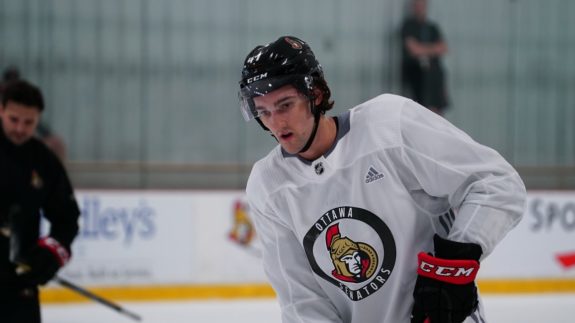
Maxence Guenette is set to make his AHL debut this season and it will be interesting to see how he fares outside the QMJHL. The reliable defenseman had a hot start to 2020-21 but eventually cooled off, likely due to the Val-d’Or Foreurs adding Samuel Poulin, Jordan Spence, Maxim Cajkovic, and Nathan Lagare. After that, he wasn’t as noticeable, but that may not be a bad thing. He doesn’t have a standout skill but can support his team reliably in any situation, which makes him another name to watch as he joins Belleville.
Kevin Mandolese had a tough go with his first professional season. With Belleville, he only appeared in nine games, posting a 3-6-0 record, a 0.888 SV%, and a 4.03 goals-against average, all of which sat near the bottom of the team. It doesn’t help that he had to compete with Gustavsson and then Sogaard at the end of the season, plus Anton Forsberg, Marcus Hogberg, Joey Daccord, and Cedric Andre for playing time. The Senators are filled to the brim with talented goalies, and while it will help the others now that Daccord and Hogberg are gone, as will the return of a full schedule for the ECHL, but it seems Mandolese has the short straw and will need a monster season to leapfrog up the depth chart.
It’s tough to guess how Eric Engstrand will develop. An overage prospect selected in the fifth round of the 2020 Draft, he spent the 2020-21 season playing in the Swedish Hockey League, where he ended with five points. However, he was the 15th most-deployed player under 21 years old in the league, playing 45 games for the Malmo Redhawks. To see his team trust him so much is a positive sign, and now, with a full season under his belt, the offence should follow. But whether he decides to take his talents to North America is anyone’s guess.
Kole Sherwood is one of the most recent additions to the Senators’ Prospect Pyramid but likely won’t make much of an impact. He’s been playing professional hockey since 2017-18 and has earned a few call-ups with the Columbus Blue Jackets, but is now plying his trade with a new franchise after signing on as a free agent this past summer. Ottawa knows what they’re getting with him, and he won’t push for a roster spot, but can provide leadership in the AHL and be relied on for a depth role should an injury open up a spot.
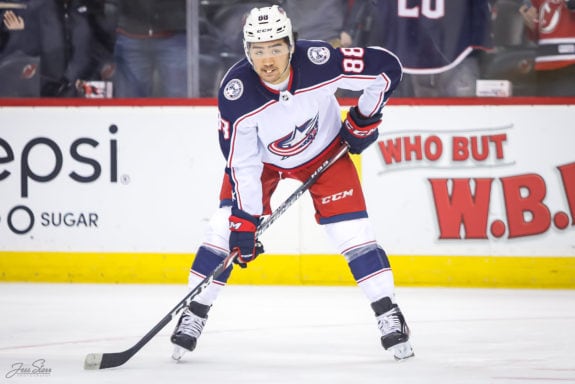
Clark Bishop, another recent addition to the Senators’ prospect group, has even more experience than Sherwood, joining the Carolina Hurricanes organization in 2016-17 and coming to Ottawa last season, where he snuck into 13 games and recorded three assists. He’s a faceoff specialist and can also provide good defensive pressure. He’ll start the season in the minors, which is where he’ll spend most of his time this season, but the Senators know he can be relied on in a pinch to fill out the bottom-six.
The final two prospects are all 20201 selections, which doesn’t speak highly of the Senators’ drafting last year. Chandler Romeo is likely the most interesting player as he stands 6-foot-5, but was one of the many OHL players to lose an entire season, and as a seventh-round pick, hopes aren’t high that he makes the NHL. Third-round pick Oliver Johansson is in a similar position, having played a total of 15 games last season over three leagues. He’s set to make his SHL debut this season, and so far has shown good offence in Sweden’s U20 circuit, but it’s really hard to judge someone’s potential without seeing them over a full season.
Tier 6: Everyone Else
Players in this tier either are a long shot to make the NHL or have limited data available.
This includes Victor Lodin, Luke Loheit, Olle Alsing, and Jonathan Aspirot.
Senators Still Have a Well-Stocked Cupboard
Despite the fact that the Senators are shifting from adding high-end talent to building a more complete roster, Ottawa still boasts one of the best prospect groups in the NHL, and many of their top young players will be pushing for roster spots in the near future. Formenton, Pinto, and likely one of Bernard-Docker or Thomson will earn significant playing time in the NHL this season, and Greig, Sanderson, and Kelly will soon follow. That’s a lot of talent to look forward to, especially in Tier Three, and if they can keep their core together, could create a dangerous roster.
This season, there are plenty of players to keep an eye on, but Järventie, Sogaard, Latimer, Romeo, Thomson, and Crookshank have the most potential to break out and jump up to a higher Tier next season. It will also be worth paying attention to Boucher, Sokolov, and Daoust, as they have the highest potential to regress or take a step backward. Please make note that I’m not saying that they will, but that they will be under the most pressure, and I’m sure every fan is hoping that they can rise to the occasion. Because despite everything that has happened with this franchise, the fans are still hopeful that management has built a team that can win a championship. That’s always been the goal, and after many seasons of poor finishes, the prospect pool is starting to pay dividends.